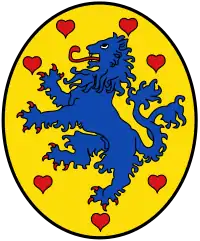
The following is a list of all princes of Lüneburg during its time as an independent principality.
The Principality of Lüneburg (German: Fürstentum Lüneburg), later also called Celle, was a territory within the Holy Roman Empire that existed from 1269 to 1705, whose land covered part of the modern-day German state of Lower Saxony. The territory was granted imperial immediacy which gave it the special status of reporting directly to the emperor. It emerged in 1269 following the division of the Duchy of Brunswick-Lüneburg, and its rulers continued to use the title of dukes of Brunswick-Lüneburg. Lüneburg lost its independence in 1705 when it was inherited by the Principality of Calenberg (also known as Hanover), which however could keep a separate seat in the Reichstag for Lüneburg or "Brunswick-Celle".
Princes of Lüneburg
Old House of Lüneburg
| Portrait | Name | Rule | Remarks |
|---|---|---|---|
| John (1242-1277) | 1269 - 1277 | Following the division of the Duchy of Brunswick-Lüneburg, John was the first ruler of the new Principality of Lüneburg. | |
 |
Otto II the Strict (1266-1330) | 1277 - 1330 | Otto II of Brunswick-Lüneburg after Otto the Child (Otto I of Brunswick-Lüneburg) |
| Otto III (1296-1352) | 1330 - 1352 | ||
.jpg.webp) |
William († 1369) | 1330 - 1369 | William II of Brunswick-Lüneburg. His death precipitated the Lüneburg War of Succession in 1370. |
Old House of Brunswick
| Portrait | Name | Rule | Remarks |
|---|---|---|---|
 |
Magnus Torquatus (1328-1373) | 1369 - 1373 | Magnus II. "Magnus with the Necklace." 2nd cousin, once removed, of William II |
Dukes of Saxe-Wittenberg
| Portrait | Name | Rule | Remarks |
|---|---|---|---|
 |
Albert of Saxe-Wittenberg (d 1385) | 1370 - 1385 | Albert moved the residence to Celle after the slighting of Lüneburg Castle. |
 |
Wenceslas of Saxe-Wittenberg (d 1388) | 1370 - 1388 | |
Middle House of Brunswick
| Portrait | Name | Rule | Remarks |
|---|---|---|---|
.jpg.webp) |
Henry I the Mild (d 1416) | 1388 - 1416 | |
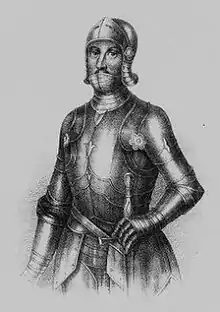 |
William the Victorious (1392-1482) | 1416 - 1428 | |
| Henry II the Peaceful (1411-1473) | 1416 - 1428 | ||
Middle House of Lüneburg
| Portrait | Name | Rule | Remarks |
|---|---|---|---|
 |
Bernard I (d 1434) | 1388 - 1409 and 1428 - 1434 |
|
.jpg.webp) |
Otto I the Lame (d 1446) | 1434 - 1446 | Otto IV of Brunswick-Lüneburg. Also "Otto Crookleg". |
 |
Frederick the Pious (d 1478) | 1434 - 1457 and 1472 - 1478 |
Frederick II |
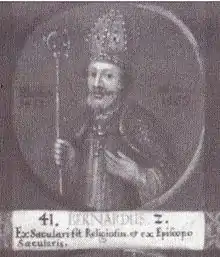 |
Bernard II (1432-1464) | 1457 - 1464 | Also Prince-Bishop of Hildesheim as Bernard III (1452–1458) |
 |
Otto II the Magnanimous (1439-1471) | 1457 - 1471 | Otto V of Brunswick-Lüneburg |
 |
Henry I of Lüneburg (1468-1532) | 1486 - 1520 | |
 |
Otto I of Harburg (1495-1549) | 1520 - 1527 | Otto VI of Brunswick-Lüneburg |
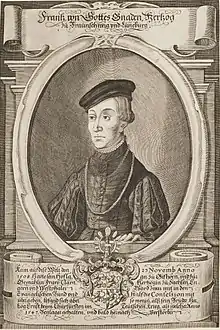 |
Francis (1508-1549) | 1536 - 1539 | |
_-_Ernst_der_Bekenner%252C_Herzog_von_Braunschweig-L%C3%BCneburg-Celle.jpg.webp) |
Ernest the Confessor (1497-1546) | 1520 - 1546 | Ernest I. Introduced the Reformation into the Principality of Lüneburg in 1527. He was also the progenitor of the Calenberg-Celle and Wolfenbüttel lines |
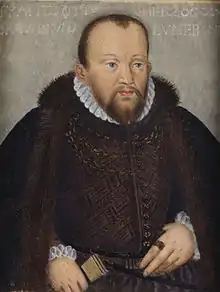 |
Francis Otto (1530-1559) | 1555 - 1559 | |
| Henry of Dannenberg (1533-1598) | 1559 - 1569 | Henry III | |
 |
William the Younger (1535-1592) | 1559 - 1592 | |
 |
Ernest II (1564-1611) | 1592 - 1611 | |
 |
Christian (1566-1633) | 1611 - 1633 | |
.jpg.webp) |
Augustus the Elder (1568-1636) | 1633 - 1636 | Augustus |
.jpg.webp) |
Frederick (1571-1648) | 1636 - 1648 | |
New House of Lüneburg
| Portrait | Name | Ruled from | To | Remarks |
|---|---|---|---|---|
.jpg.webp) |
Christian Louis Christian Ludwig |
10 December 1648 | 15 March 1665 | Nephew of the previous duke; he was already Duke of Brunswick-Calenberg, which he resigned to his next brother to take up the rule of this duchy. |
.jpg.webp) |
John Frederick (1625-1679) Johann Friedrich |
1665 | ||
 |
George William Georg Wilhelm |
15 March 1665 | 28 August 1705 | Brother of Christian Louis, previously ruler of Brunswick-Calenberg |
| In 1705 the Principality of Lüneburg was united with the Electorate of Brunswick-Lüneburg through inheritance. | |
See also
Sources
- Geckler, Christa (1986). Die Celler Herzöge: Leben und Wirken 1371–1705. Celle: Georg Ströher. ISBN 3-921744-05-8. OCLC 255990175.
- William Havemann: Geschichte the Lande Brunswick und Lüneburg, 3 Bde., Nachdruck. Hirschheydt, Hannover 1974/75, ISBN 3-7777-0843-7 (Originalausgabe: Verlag the Dietrich'schen Buchhandlung, Göttingen 1853–1857)
- Hans Patze (Begr.): Geschichte Niedersachsen, 7 Bde. Hahnsche Buchhandlung, Hannover 1977- (Veröffentlichungen the Historischen Kommission für Niedersachsen und Bremen, 36)